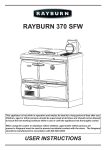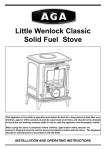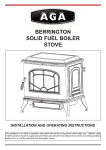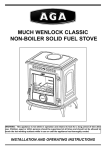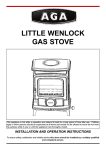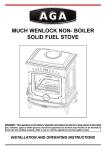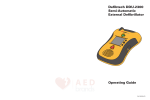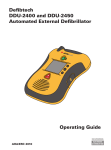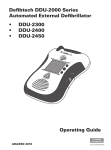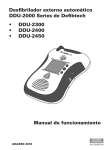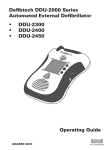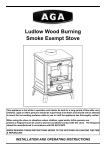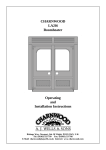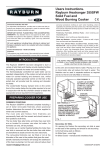Download AGA MINSTERLEY Operating instructions
Transcript
MINSTERLEY SOLID FUEL BOILER STOVE INSTALLATION AND OPERATING INSTRUCTIONS This appliance is hot while in operation and retains its heat for a long period of time after use. Children, aged or infirm persons should be supervised at all times and should not be allowed to touch the hot working surfaces while in use or until the appliance has thoroughly cooled. When using the boiler stove in situations where children, aged and/or infirm persons are present a fireguard must be used to prevent accidental contact with the stove. The fireguard should be manufactured in accordance with BS 6539. TABLE OF CONTENTS PAGE NO. 1. 2. 3. 4. 5. 6. 7. 8. 9. 10. 11. 12. 13. 14. 15. 16. 17. 18. 19. 20. 21. 22. 23. 24. 25. 26. 27. 28. 29. 30. 31. 32. 33. 34. 35. 36. 37. 38. 39. 40. 41. 42. General . . . . . . . . . . . . . . . . . . . . . . . . . . . . . . . . . . . . . . . . . . . . . . . . . . . . . . . . . . . . . . . . . . . . . . . 3 Handling . . . . . . . . . . . . . . . . . . . . . . . . . . . . . . . . . . . . . . . . . . . . . . . . . . . . . . . . . . . . . . . . . . . . 3 Fire Cement . . . . . . . . . . . . . . . . . . . . . . . . . . . . . . . . . . . . . . . . . . . . . . . . . . . . . . . . . . . . . . . . . 3 Asbestos . . . . . . . . . . . . . . . . . . . . . . . . . . . . . . . . . . . . . . . . . . . . . . . . . . . . . . . . . . . . . . . . . . . . 3 Metal Parts . . . . . . . . . . . . . . . . . . . . . . . . . . . . . . . . . . . . . . . . . . . . . . . . . . . . . . . . . . . . . . . . . . 3 Pre-Installation Assembly . . . . . . . . . . . . . . . . . . . . . . . . . . . . . . . . . . . . . . . . . . . . . . . . . . . . . . . . . 3 Flues . . . . . . . . . . . . . . . . . . . . . . . . . . . . . . . . . . . . . . . . . . . . . . . . . . . . . . . . . . . . . . . . . . . . . . . . 4 Flue Pipes . . . . . . . . . . . . . . . . . . . . . . . . . . . . . . . . . . . . . . . . . . . . . . . . . . . . . . . . . . . . . . . . . . . . . 5 Top Flue Exit . . . . . . . . . . . . . . . . . . . . . . . . . . . . . . . . . . . . . . . . . . . . . . . . . . . . . . . . . . . . . . . . . . . 5 Rear Flue Exit . . . . . . . . . . . . . . . . . . . . . . . . . . . . . . . . . . . . . . . . . . . . . . . . . . . . . . . . . . . . . . . . . . 5 Chimney . . . . . . . . . . . . . . . . . . . . . . . . . . . . . . . . . . . . . . . . . . . . . . . . . . . . . . . . . . . . . . . . . . . . . . 5 Ventilation & Combustion Air Requirements . . . . . . . . . . . . . . . . . . . . . . . . . . . . . . . . . . . . . . . . . . . 5 Location . . . . . . . . . . . . . . . . . . . . . . . . . . . . . . . . . . . . . . . . . . . . . . . . . . . . . . . . . . . . . . . . . . . . . . . 6 Installation Clearances . . . . . . . . . . . . . . . . . . . . . . . . . . . . . . . . . . . . . . . . . . . . . . . . . . . . . . . . . . . 6 Floor Protection . . . . . . . . . . . . . . . . . . . . . . . . . . . . . . . . . . . . . . . . . . . . . . . . . . . . . . . . . . . . . . . . . 6 Flue & Water Pipe Locations . . . . . . . . . . . . . . . . . . . . . . . . . . . . . . . . . . . . . . . . . . . . . . . . . . . . . . 6 Specification . . . . . . . . . . . . . . . . . . . . . . . . . . . . . . . . . . . . . . . . . . . . . . . . . . . . . . . . . . . . . . . . . . . 7 Technical Data . . . . . . . . . . . . . . . . . . . . . . . . . . . . . . . . . . . . . . . . . . . . . . . . . . . . . . . . . . . . . . . . . . 7 Back Panel Assembly . . . . . . . . . . . . . . . . . . . . . . . . . . . . . . . . . . . . . . . . . . . . . . . . . . . . . . . . . . . . 7 Plumbing . . . . . . . . . . . . . . . . . . . . . . . . . . . . . . . . . . . . . . . . . . . . . . . . . . . . . . . . . . . . . . . . . . . . . . 7 Regulations . . . . . . . . . . . . . . . . . . . . . . . . . . . . . . . . . . . . . . . . . . . . . . . . . . . . . . . . . . . . . . . . . . . . 7 Gravity Circuit . . . . . . . . . . . . . . . . . . . . . . . . . . . . . . . . . . . . . . . . . . . . . . . . . . . . . . . . . . . . . . . . . . 7 Injector Tee . . . . . . . . . . . . . . . . . . . . . . . . . . . . . . . . . . . . . . . . . . . . . . . . . . . . . . . . . . . . . . . . . . . . 8 Water Circuit Temperature . . . . . . . . . . . . . . . . . . . . . . . . . . . . . . . . . . . . . . . . . . . . . . . . . . . . . . . . 8 Pipe Thermostat . . . . . . . . . . . . . . . . . . . . . . . . . . . . . . . . . . . . . . . . . . . . . . . . . . . . . . . . . . . . . . . . 8 Commissioning & Handover . . . . . . . . . . . . . . . . . . . . . . . . . . . . . . . . . . . . . . . . . . . . . . . . . . . . . . . 8 Important Notes . . . . . . . . . . . . . . . . . . . . . . . . . . . . . . . . . . . . . . . . . . . . . . . . . . . . . . . . . . . . . . . . . 9 Lighting . . . . . . . . . . . . . . . . . . . . . . . . . . . . . . . . . . . . . . . . . . . . . . . . . . . . . . . . . . . . . . . . . . . . . . . 10 Operating Instructions . . . . . . . . . . . . . . . . . . . . . . . . . . . . . . . . . . . . . . . . . . . . . . . . . . . . . . . . . . . . 11 Woodburning Grate . . . . . . . . . . . . . . . . . . . . . . . . . . . . . . . . . . . . . . . . . . . . . . . . . . . . . . . . . . . . . . 11 Recommended Fuels . . . . . . . . . . . . . . . . . . . . . . . . . . . . . . . . . . . . . . . . . . . . . . . . . . . . . . . . . . . . 11 Permanent Air Vent . . . . . . . . . . . . . . . . . . . . . . . . . . . . . . . . . . . . . . . . . . . . . . . . . . . . . . . . . . . . . . 11 Extractor Fan . . . . . . . . . . . . . . . . . . . . . . . . . . . . . . . . . . . . . . . . . . . . . . . . . . . . . . . . . . . . . . . . 11 Thermostat Operation . . . . . . . . . . . . . . . . . . . . . . . . . . . . . . . . . . . . . . . . . . . . . . . . . . . . . . . . . . . . 12 Secondary Air Control . . . . . . . . . . . . . . . . . . . . . . . . . . . . . . . . . . . . . . . . . . . . . . . . . . . . . . . . . . . . 12 De-Ashing . . . . . . . . . . . . . . . . . . . . . . . . . . . . . . . . . . . . . . . . . . . . . . . . . . . . . . . . . . . . . . . . . . . . . 12 Disposal of Ashes . . . . . . . . . . . . . . . . . . . . . . . . . . . . . . . . . . . . . . . . . . . . . . . . . . . . . . . . . . . . . . . 12 To Clean Chimney Back Outlet . . . . . . . . . . . . . . . . . . . . . . . . . . . . . . . . . . . . . . . . . . . . . . . . . . . . . 13 To Replace Rocker Op Sleeve . . . . . . . . . . . . . . . . . . . . . . . . . . . . . . . . . . . . . . . . . . . . . . . . . . . . . 13 Radiation Surface . . . . . . . . . . . . . . . . . . . . . . . . . . . . . . . . . . . . . . . . . . . . . . . . . . . . . . . . . . . . . . . 14 Fire Safety . . . . . . . . . . . . . . . . . . . . . . . . . . . . . . . . . . . . . . . . . . . . . . . . . . . . . . . . . . . . . . . . . . . . . 14 In Case of Fire . . . . . . . . . . . . . . . . . . . . . . . . . . . . . . . . . . . . . . . . . . . . . . . . . . . . . . . . . . . . . . . . . 14 Vitreous Enamel Cleaning . . . . . . . . . . . . . . . . . . . . . . . . . . . . . . . . . . . . . . . . . . . . . . . . . . . . . . . . . 14 Glass Cleaning . . . . . . . . . . . . . . . . . . . . . . . . . . . . . . . . . . . . . . . . . . . . . . . . . . . . . . . . . . . . . . . . . 14 Glass Replacement . . . . . . . . . . . . . . . . . . . . . . . . . . . . . . . . . . . . . . . . . . . . . . . . . . . . . . . . . . . . . . 14 Exploded View . . . . . . . . . . . . . . . . . . . . . . . . . . . . . . . . . . . . . . . . . . . . . . . . . . . . . . . . . . . . . . . . . 15 Installation Check List . . . . . . . . . . . . . . . . . . . . . . . . . . . . . . . . . . . . . . . . . . . . . . . . . . . . . . . . . . . . 16 2 THE MINSTERLEY SOLID FUEL CENTRAL HEATING STOVE INSTALLATION & OPERATING INSTRUCTIONS GENERAL The complete installation must be done in accordance with current Standards and Local Codes. It should be noted that the requirements and these publications may be superseded during the life of this manual. When installing, operating and maintaining your Minsterley Stove respect basic standards of fire safety. Read these instructions carefully before commencing the installation. Failure to do so may result in damage to persons and property. consult your local Municipal office and your insurance representative to determine what regulations are in force. Save these instructions for future reference. PRE-INSTALLATION ASSEMBLY (a) (b) Please note that it is a legal requirement under England & Wales Building Regulations that the installation of the stove is either carried out under Local Authority Building Control approval or is installed by a Competent Person registered with a Government approved Competent Persons Scheme. HETAS Ltd operate such a scheme and a listing of their Registered Competent Persons can be found on their website at www.hetas.co.uk. After removing the stove from its pack, open the ashpit door and remove the contents. Open the firedoor using the handle and remove the contents from the firebox. See Fig.1. Fig.1 Special care must be taken when installing the stove such that the requirements of the Health & Safety at Work Act are met. Handling Adequate facilities must be available for loading, unloading and site handling. (c) Fire Cement Some types of fire cement are caustic and should not be allowed to come into contact with the skin. In case of contact with the skin wash immediately with plenty of water. (d) (e) Asbestos This stove contains no asbestos. If there is a possibility of disturbing any asbestos in the course of installation then please seek specialist guidance and use appropriate protective equipment. Remove the ashtray from the top plastic packing piece if you have not already done so. Remove loose fitting hob and place on a non abrasive surface. Place the plastic packing on the ground at the back of the stove and lay the stove on its back on top of the packing. Remove the wooden pallet by taking out the two retaining screws from the base of the stove. See Fig.2. Fig.2 Metal Parts When installing or servicing this stove care should be taken to avoid the possibility of personal injury. “IMPORTANT WARNING” This stove must not be installed into a chimney that serves any other heating appliance. (f) There must not be an extractor fan fitted in the same room as the stove as this can cause the stove to emit fumes into the room. 3 Fit the four legs to the base of the stove with the four 5/8” x 5/16” (16mm x 8mm) screws provided. Fit the ashtray with the two 3/4” x 1/4” (20mm x 6mm) screws provided. Tighten all screws. Stand the stove upright taking care not to strain the back leg bolts. See Fig.3. Fig.4 Fig.3 2300 600 Ash Tray & Legs Assembly FLUES Flues should be vertical wherever possible and where a bend is necessary, it should not make an angle of more than 45o with the vertical. Horizontal flue runs should be avoided except in the case of a back outlet from the appliance, when the length of the horizontal section should not exceed 150mm. Appliance In order to minimise flue resistance and to make sweeping easier it is recommended to use 2 x 45o bends rather than a 90o bend. Soot Door FLUE PIPES A flue pipe should only be used to connect an appliance to a chimney and should not pass through any roof space. The flue termination point must be located to minimise any wind effects. Wind effects of suction, pressure zones and turbulence can be created by the roof and adjacent objects. Wind effects can also be created by natural land contours. Flue pipes may be of any of the following materials: (a) Cast iron as described in BS 41: 1973 (1981), or (b) Stainless steel with a wall thickness of at least 1mm and as described in BS EN 10095:1999 Specification for stainless and heat resisting steel plate, sheet and strip, for Grade 316 S11, 316 S13, 316 S16, 316 S31, 316 S33, or the equivalent Euronorm 88-71 designation, or (c) Vitreous enamelled steel complying with BS 69990: 1989. To minimise the wind effects, the flue termination point should be located a minimum of 600mm from the roof measured vertically and 2300mm measured horizontally. Where this termination point does not suffice it may be necessary to extend the flue pipe so that the termination point is above the apex. (See Fig.4) Flue pipes with spigot and socket joints should be fitted with the socket uppermost. Clearance to combustibles must be adhered to when fitting the flue pipe. The flue gas mass flow is 9.2 g/s solid mineral fuel and 6.7 g/s wood logs. The mean flue gas temperature measured directly downstream of the spigot at nominal heat output is 330 oC. The appliance is suitable for continuous operation on solid mineral fuel and intermittent operation on wood logs. 4 TOP FLUE EXIT CHIMNEY When connecting to a flue pipe it is necessary to provide an access door in the pipe for flue and chimney cleaning. It is not possible to clean the chimney through the stove. Take the flue spigot and before fitting it to the stove place a small amount of fire cement on the inside flange of the outlet and push the flue spigot into place making sure the spigot is properly sealed to the stove. Remove any excess cement from the inside of the flue spigot to prevent obstruction of the flue way. See Fig.5. Do not connect to a chimney serving another appliance. The stove is a radiant room heater and must be connected to a chimney of the proper size and type. The chimney must have a cross-sectional area of at least 30 square inches 19350sq. mm or a diameter of at least 6” (150mm). It is best to connect to a chimney of the same size, as connection to a larger size may result in a somewhat less draught. Minimum chimney height 15’ (4.5 meters) from floor on which stove is installed. An existing masonry chimney should be inspected and if necessary repaired by a competent mason. The stove must be connected to a chimney with a minimum continuous draft of 12 pa, poor draft conditions will result in poor performance. Fig.5 Flue Spigot In adverse weather conditions, down drafts may be experienced causing smoke or fumes to spill into the room. If this occurs shut the appliance down by closing the air controls. If the problem persists seek the advice of a chimney sweep. Screws VENTILATION & COMBUSTION AIR REQUIREMENTS It is imperative that there is sufficient air supply to the stove in order to support correct combustion. The air supply to this appliance must comply with current Building Regulations. Rear Cover Plate REAR FLUE EXIT The minimum effective air requirement for this appliance is 40.15cm2. This is increased to 77cm2 where a flue draught stabiliser is fitted. If another appliance is fitted in an adjacent room it will be necessary to calculate an additional air supply. Fit the top cover plate to the stove with the two screws holding on the rear exit cover plate making sure that the sealing rope is properly seated on the stove flue outlet. Tighten screws. Air vents should be of the correct size, maintained and kept free of obstruction. It is recommended that a minimum clearance of 100mm be maintained from the sides and rear of the appliance to a tiled fireplace or masonry wall, especially on the right of the appliance as access is required for the controls. See Fig.6. PERMANENT AIR VENT The stove requires a permanent and adequate air supply in order for it to operate safely and efficiently. In accordance with current Building Regulations the installer will have fitted a permanent air supply vent into the room in which the stove is installed to provide combustion air. This air vent should not under any circumstances be shut off or sealed. Fig.6 Top Cover Plate Extractor Fan There must not be an extractor fan fitted in the same room as the stove as this can cause the stove to emit smoke and fumes into the room. Rear Flue Exit 5 LOCATION Fig.8 There are several conditions to be considered in selecting a location for your stove. a. Position in the area to be heated- central locations are usually best. 318mm (121/2) b. Allowances for proper clearances to combustibles. 460mm (181/9) INSTALLATION CLEARANCES Maintain at least the following clearances to all combustible material: From the front 910 mm (36”) From the back 100 mm (4”) From the sides 100 mm (4”) From the flue pipe 910 mm (36”) straight up only Brick wall minimum clearance, but allow access for controls and water fittings. Fig.9 FLOOR PROTECTION It is recommended that this appliance is installed on a solid, level, non combustible hearth conforming to current Building Regulations. Fig.7 FLUE & WATER PIPE LOCATIONS Flue outlet to suit 152mm 6”) internal diameter flue pipe. Water outlets 25mm (1”) B.S.P. WARNING: DO NOT OBSTRUCT PRIMARY AIR SUPPLY TO THE AIR DUCT AT THE RIGHT HAND SIDE OF THE STOVE 6 SPECIFICATION Fig.10 NOTE: Dimensions stated are in millimetres and may be subject to a slight +/- variation. TECHNICAL DATA Nominal Output Manufactured Smokeless Fuel Nominal Output Wood logs Room 3.6kW Water 7.5kW Room 5.0kW Water 7.3kW Typical refuelling intervals to obtain nominal outputs Flue Gas Mass Flow Flue Gas temp at nominal output Wood MSF MSF Wood logs 330 oC Gross Weight: 178 kgs Boiler capacity 9.3 litres Max operating water pressure 2 bar Boiler tappings 1” BSP Flue Outlet Log size 153 mm 1.5 hours 4 hours 9.2 g/s 6.7 g/s 406 mm This appliance has been tested in accordance with BS EN 13240 atmosphere. The central heating will normally be pump-driven as with other types of boilers. BACK PANEL ASSEMBLY When the stove is installed attach the thermostat cover plate and the left hand side panel with the screws provided 1/4” x 1/2” (M6 x 12). Fix the top panel to these with the screws provided (No.6 x 1/2” self tapping screws). GRAVITY CIRCUIT The gravity circuit consists of the domestic hot water tank of 135 litres indirect cylinder, fixed in an upright position, recommended for hot water storage and it should be connected to the boiler by 28mm diameter flow and return piping. The pipes should not exceed 7.8 meters (25ft) in length and cylinder and pipework should be fully lagged. The shorter the run of pipe work the more effective the water heating heating.There must be no gate valves on this circuit and it must have an expansion pipe exhausting to PLUMBING REGULATIONS The plumbing must be in accordance with all relevant regulations and practices. It must include a gravity circuit with expansion pipe, open to the 7 atmosphere. Cylinder and pipe work should be lagged to minimise heat loss. A drain cock should be fitted at the lowest point of the circuit. satisfied. Be aware that steam and boiling water will be expended from any open vent from the heating system probably in the roof space at the expansion tank. This diagram illustrates the basic principal of water heating systems and must not be regarded as a working drawing. See Fig.11. In the unlikely event that the appliance is not operating in freezing conditions the water must be drained from the boiler to prevent frost damage. Fig.11 PIPE THERMOSTAT The fitting of a pipe thermostat to the flow pipe is essential in order to activate the water circulation pump when the water reaches the selected temperature. When the water temperature falls below the selected temperature the pipe thermostat will cut off the water circulation pump in order to allow the boiler to recover. Fig.12 INJECTOR TEE Where the gravity and central heating circuits join together to return to the stove we recommend the use of an injector tee connection, situated as close to the unit as possible. This type of tee encourages a stable flow of hot water through both circuits and helps to prevent priority being given to the stronger flow, which is most commonly the pumped central heating circuit. This way, there will be no shortage of hot water to the taps when the heating is on. COMMISSIONING & HANDOVER WATER CIRCUIT TEMPERATURE On Completion of the installation and commissioning ensure that the operating instructions for the stove are left with the customer. Ensure to advise the customer on the correct use of the appliance with the fuels likely to be used on the stove and warn them to use only the recommended fuels for the stove. On completion of the installation allow a suitable period of time for any fire cement and mortar to dry out, when a small fire may be lit and checked to ensure the smoke and fumes are taken from the stove up the chimney and emitted safely to the atmosphere. Do not run at full output for at least 24 hours. The return water temperature should be maintained at not less than 40°C so as to avoid condensation on the boiler and return piping. Fitting a pipe thermostat to the return pipe of the gravity circuit and wiring it into the pump control will ensure rapid circulation of the hot water. Advise the user what to do should smoke or fumes be emitted from the stove. The customer should be warned to use a fireguard to BS 6539 in the presence of children, aged and/or infirm persons. In some circumstances it may be possible to overheat the appliance and the water inside will boil. This will be evident by the sound of a knocking noise coming from the appliance and pipes around the house. If this occurs close off all air controls and manually start the central heating pump if fitted. One radiator on the heating circuit should be uncontrolled to act as a heat leak in the event that the appliance overheats and has nowhere to discharge a build up of hot water should the heating circuit be 8 IMPORTANT NOTES Now that your Solid Fuel Stove is installed and no doubt you are looking forward to many comforts it will provide, we would like to give you some tips on how to get the best results from your stove. 1. We would like if you could take some time to read the operating instructions/hints, which we are confident, will be of great benefit to you. 2. Do not burn fuel with a high moisture content, such as a damp or unseasoned timber. This will only result in a build up of tar in the stove and in the chimney. FUEL CALORIFIC VALUES - SOLID FUELS Anthracite 25-50mm House Coal 25-75mm C.V.: 8.2kW/Kg C.V.: 7.2kW/Kg 14,000 BTUs/lb 12,000 BTUs/lb Timber - Firebox size C.V.: 5.0kW/Kg 8,600 BTUs/lb Peat Briquettes C.V.: 4.8kW/Kg 8,300 BTUs/lb 3. Clean the flue-ways of the stove weekly and ensure that there are no blockages. Check flueways before lighting especially after a shut down period. Please refer to manual for instructions. 4. Before loading fresh fuel into the firebox, riddle fully to remove all ashes, this will allow better and cleaner burning. See Re-Fuelling Section. 5. Never allow a build up of ashes in the ash pan, as this will cause the grate to burn out prematurely. Empty the ashpan when re–fuelling. 6. Allow adequate air ventilation to ensure plenty of air for combustion. 7. Do not use as an incinerator burning rubbish/household waste. 8. Do not leave ash door open for long periods as this will over heat the unit causing unnecessary damage. Close the ash door between removing and replacing the ashpan. 9. Clean the chimney at least twice a year. 10. Burning soft fuels such as timber or peat will stain the glass. Regular cleaning will prevent permanent staining. Clean with soapy water when cool. 11. Keep all combustible materials a safe distance away from unit, please consult manual for clearance to combustibles table. 12. For safety reasons never leave children or the elderly unaccompanied while stove is in use. Use a fire guard. 13. Avoid contact with the appliance when in use as stove reaches very high operating temperatures. 14. This appliance should be regularly maintained by a competent service engineer. Use only replacement parts recommended by AGA. Making unauthorised modifications, or using unauthorised parts will invalidate your guarantee and may cause damage or injury. AN ODOUR WILL EMIT FROM STOVE ON FIRST FIRING, WHEN FIRE REACHES MAXIMUM TEMPERATURE OVER A NUMBER OF HOURS THIS ODOUR WILL SUBSIDE. IT IS BEST ADVISED TO OPEN WINDOWS DURING THIS PERIOD. THIS ODOUR IS UNPLEASANT BUT NOT TOXIC. YOU MAY WISH TO VACATE THE ROOM WHILE THE PAINT CURES. 9 LIGHTING Before lighting the stove check with the installer that the installation work and commissioning checks described in the installation instructions have been carried out correctly and that the chimney has been swept clean, is sound and free from any obstructions. As part of the stove’s commissioning and handover the installer should have demonstrated how to operate correctly. Fig.13 1. Open firedoor and open the primary air inlet by turning the control knob on the right hand side of the stove to setting 4 on the thermostat. 2. Open the secondary air inlet by turning it anti-clockwise for coal and wood only. 3. Cover with crumpled pieces of paper. 4. Lay 10-12 pieces of kindling on top of the paper towards the back of the firebox. 5. Ignite and close the firedoor. 6. Under no circumstances should any flammable liquid i.e. petrol, paraffin etc., be used to light the fire 7. When the kindling is well alight open the firedoor and add more kindling of a larger size to sustain the fire. Close the firedoor. 8. When a hot bed of coal is established add the normal fuel. 9. When well lighted, adjust the thermostat to give the required heat output. 10. To shut the fire down, do not add fuel, make sure that the firedoor is properly closed and that the primary and secondary air controls are all in the closed position. Cutting off the air supply will reduce the heat output. 11. Following a prolonged shutdown of the appliance perhaps after the summer break, ensure the flueway is free from obstruction prior to re-lighting. Re-fuelling-Open the firedoor and reload, close the firedoor. 10 OPERATING INSTRUCTIONS Fig.14 WOOD BURNING GRATE The standard grate in this appliance consisting of three moving firebars is suitable for burning all fuels but more suited to burning solid mineral fuel (coal). A flat grate with holes is provided to burn wood only. Do not use this plate to burn solid mineral fuels as it will overheat and damage will be caused. If this appliance is used to burn wood only, insert the wood burning grate on top of the standard grate. This will prevent the wood burning away so quickly in one spot and give a better even burn. If this grate is used the riddling mechanism will have no effect and the ashpan will need emptying occasionally. Fig.15 RECOMMENDED FUELS Primary Air Thermostat Knob All fuels should be stored under cover and kept as dry as possible prior to use. This appliance has been tested using seasoned wood logs and manufactured briquetted smokeless fuel (Ancit) for closed appliances, sized between 20g and 140g. Other fuels are commercially available and may give similar results. Wood logs up to 406mm long are suitable. All fuels should be stored under cover and kept as dry as possible prior to use. Secondary Air Knob Do not use fuels with a Petro-coke ingredient as this may cause the grate to overheat, causing damage. Reduced outputs will result when fuels of lower calorific values are used. Never use gasoline or gasoline type lantern fuel, kerosene, charcoal lighter fluid or similar liquids to start or freshen up a fire in this heater. Keep all such liquid well away from the heater at all times. Operate the stove only with the fuelling door closed except for re-fuelling. WARNING: Properly installed, operated and maintained this stove will not emit fumes into the dwelling. Occasional fumes from de-ashing and re-fuelling may occur. However, persistent fume emission is potentially dangerous and must not be tolerated. If fume emission does persist, then the following immediate action should be taken - A wood burning grate is supplied for burning wood only. If this is used the riddling mechanism will have little effect. This grate is to be used for wood fuels only. It is not suitable to burn coal and damage will be caused if burning solid mineral fuels. To fit the wood burning grate, make sure that the reciprocating grate is fitted and clean. Place the wood burning grate on top of the reciprocating grate so that the return edges fold downwards to provide a support. It is fitted with the single hole towards the front of the stove and the plate pushed towards the rear. See Fig.14. (a) Open doors and windows to ventilate room. (b) Let the fire out or eject and safely dispose of fuel from the stove. (c) Check for flue or chimney blockage and clean if required. (d) Do not attempt to relight the fire until the cause of the fume emission has been identified and corrected. If necessary seek expert advice. This stove has obtained HETAS Ltd approval for burning natural and manufactured smokeless fuels and wood logs only as detailed in recommended fuels below. HETAS Approval does not cover the use of other fuels either alone or mixed with the recommended fuels listed, nor does it cover instructions for the use of other fuels. The most common cause of fume emission is flueway or chimney blockage. For your own safety these must be kept clean at all times. 11 THERMOSTAT OPERATION Fig.18 Fig.16 Setting Setting Setting Setting Setting 0: 1: 2: 3: 4: Closed 1/4 Open 1/2 Open 3/4 Open Full Open Overnight Burning Slowburning Medium burning Maximum Heat DISPOSAL OF ASHES Your stove is provided with a steel ashpan. This ashpan should be emptied every day. Rotate the knob to give the required burning rate. SECONDARY AIR CONTROL OPEN CLOSE If ashes are allowed to build to grate level you could damage the firebars by overheating. We recommend that you remove ashes after you have riddled the fire following overnight burn. When burning coal, timber or peat. When burning anthracite and smokeless fuels. Ashes should be placed in a metal or other noncombustible container with a tight fitting lid. The closed container of ashes should be placed on a non-combustible material, pending final disposal. If ashes are buried in soil, or otherwise dumped they should be retained in the closed container until they are thoroughly cooled. See Fig.19. Fig.17 Fig.19 The secondary air control knob is hot when the appliance is in use. The ashpan handle is a combined operating tool and can be used to operate this knob or use the glove provided. DE-ASHING When ash build-up becomes excessive in the fire chamber shake the firebars by inserting the operating tool into the square slot on the right side of the stove. 12 Replace ashpan. Close ashpit Door. TO REPLACE ROCKER OPERATING SLEEVE Fig. 20 1. Remove the 3 fire bars. 2. Lift the grate at the left hand end and remove it. 3. Withdraw the Rocker Operating Sleeve from under the boiler at the right hand side. 4. Replace with new sleeve and sealing washer. 5. Replace grate and make sure that the square shank on the centre fire bar engages with the socket in the sleeve. Fig.22 Grate Rocker Operating Sleeve 1. 2. 3. 4. 5. Lift off hob. Remove 4 brass screws. Lift off fire box cover. Clean out fire box chamber. Replace all parts in reverse order. RADIATION SURFACE Heating surface only 23.87 Sq. M (257 sq. ft.) Heating plus Domestic Hot Water 18.58 Sq. M. (200 sq.ft.) TO CLEAN CHIMNEY BACK OUTLET Remove baffle underneath the boiler cross flow chamber by lifting it upwards and pulling it outwards and insert cleaning brush. Replace baffle before lighting fire. FIRE SAFETY When fitted correctly the baffle should fall forward to close onto the bottom of the boiler. The appliance will not function correctly with this baffle misaligned or missing. 1. Do not over fire the stove. 2. Over-firing will also damage painted or enamel finish. 3. Install a smoke detector in the room. 4. A conveniently located class A fire extinguisher to contend with small fires resulting from burning embers. 5. A practical evacuation plan. 6. A plan to deal with a chimney fire as follows:- To provide reasonable fire safety, the following should be given serious consideration. Fig.21 Boiler (a) Notify the fire department. (b) Prepare occupants for immediate evacuation. (c) Close all openings into the stove. (d) While awaiting the fire department watch for ignition to adjacent combustibles from over heated flue pipe or from embers or sparks from the chimney. Removable Baffle Grate 13 Fig.23 IN CASE OF FIRE Close all openings into the stove, watch for ignition of adjacent combustibles from over heated stove, or hot embers or sparks from chimney. VITREOUS ENAMEL CLEANING General cleaning must be carried out when the stove is cool. If this stove is finished in a high gloss vitreous enamel, to keep the enamel in the best condition observe the following tips: 1. Wipe over daily with a soapy damp cloth, followed by a polish with a clean dry duster. Replacement Glass GLASS REPLACEMENT 2. For stubborn deposits a soap impregnated pad can be carefully used on the vitreous enamel. (a) (b) 3. Use only products recommended by the Vitreous Enamel Association, these products carry the Vitramel label. (c) (d) (e) Association (f) (g) 4. DO NOT USE ABRASIVE PADS OR OVEN CLEANSERS CONTAINING CITRIC ACID ON ENAMELLED SURFACES. ENSURE THAT THE CLEANSER MANUFACTURERS INSTRUCTIONS ARE ADHERED TO. GLASS CLEANING The glass will self clean when there is sufficient heat generated by the burning fuel. If a build-up of creosote occurs on the glass it may be due to draft conditions, poor quality fuel or very low burning for a long time. It is best to clean the glass when it is thoroughly cooled. 14 Open the firedoor fully. Remove the four corner screws and clips and carefully remove the broken glass. Clean the glass recess in the door. Attach adhesive thermal tape to the perimeter of the replacement glass. Place the thermal tape side of the glass into the door recess and replace the four corner clips. Tighten screws. Replace glass only with ceramic glass 5mm thick. See Fig.23. EXPLODED VIEW ITEMS 1. 2. 3. 4. 5. 6. 7. 8. 9. 10. 11. 12. 13. 14. 15. 16. 17. 18. Top Flue Outlet Leg (Short) Top Flue Blanking Plate Hob Air Wash Control Knob Flue Blanking Plate Right Hand Side Panel Left Hand Side Panel Front Frame Base Ashtray Top Shroud RH Back Shroud Gasket Clamp Plate Top Latch Socket Cover Plate Lower Latch Socket Cover Plate LH Back Shroud Boiler Assembly 19. 20. 21. 22. 23. 24. 25. 26. 27. 28. 29. 30. 31. 32. 33. 34. 35. 36. 37. Bottom-Shroud Bracket Rating Plate Bracket Ashpan Fire Bed Flue Side Baffle Baffle Support Lefthand Front Brick Righthand Front Brick Side Insulation Grate Assembly Thermostat Assembly Ashpit Door Assembly Min Spring Handle Fire Door Assembly Inner Top Serial Number Plate Data Plaque Gasket 2” Primary Air Box 15 38. 39. 40. 41. 42. 43. 44. 45. 46. 47. 48. 49. 50. 51. 52. 53. 54. 55. 56. Primary Air Shutter Grate Support Shaker Barrell Fire Fence Retainer Air Control Knob Operation Tool Primary Air Control Shaft Spacer to Door Handle Aga Stove Badge Fire Fence Boiler Cleaning Plate 2” Hinge Door Handle Axle Door Latch Door Handle Axle Door Grill Glass Door glass Clip Access Plate INSTALLATION CHECK LIST Tick Flue System √ 1. Minimum Flue Height of 4.5 metres (15 feet). 2. Appliance should be connected to a minimum of 1.8 metres (6 feet) of 150mm (6”) flue pipe with a horizontal run not exceeding 300mm (12”). 3. Appliance should be connected to a chimney of less than 200mm (8”) in diameter (otherwise the chimney must be lined with a 6” flue liner). 4. The chimney venting position must be above the main ridge of the roof or adjacent outside obstructions. 5. The chimney serving this appliance should not serve any other appliance. 6. Access should be provided to the chimney serving the appliance to allow for cleaning. Location 7. Clearance to combustible materials must be adhered to as described in the Clearance to Combustible section. 8. The stove must be installed on a solid non-combustible hearth conforming to Building Regulations. Plumbing 9. Appliance must be connected to a gravity circuit using 1” ID flow & return piping. 10. The length of pipes from the cylinder to the stove should not exceed 7.8 metres (251/2 feet). 11. A circulation pump should be fitted to the return pipe of the radiator circuit and controlled by a pipe stat fitted to the flow pipe of the gravity circuit to the cylinder. Ventilation & Combustion Air Requirements 12. The room in which the appliance is located should have an air vent of adequate size to support correct combustion (see Ventilation & Combustion Air Requirement Section for specific details). Aga, Station Road, Ketley, Telford, Shropshire, TF1 5AQ, UK 16 Ref: N00455AXX DP 100118
















